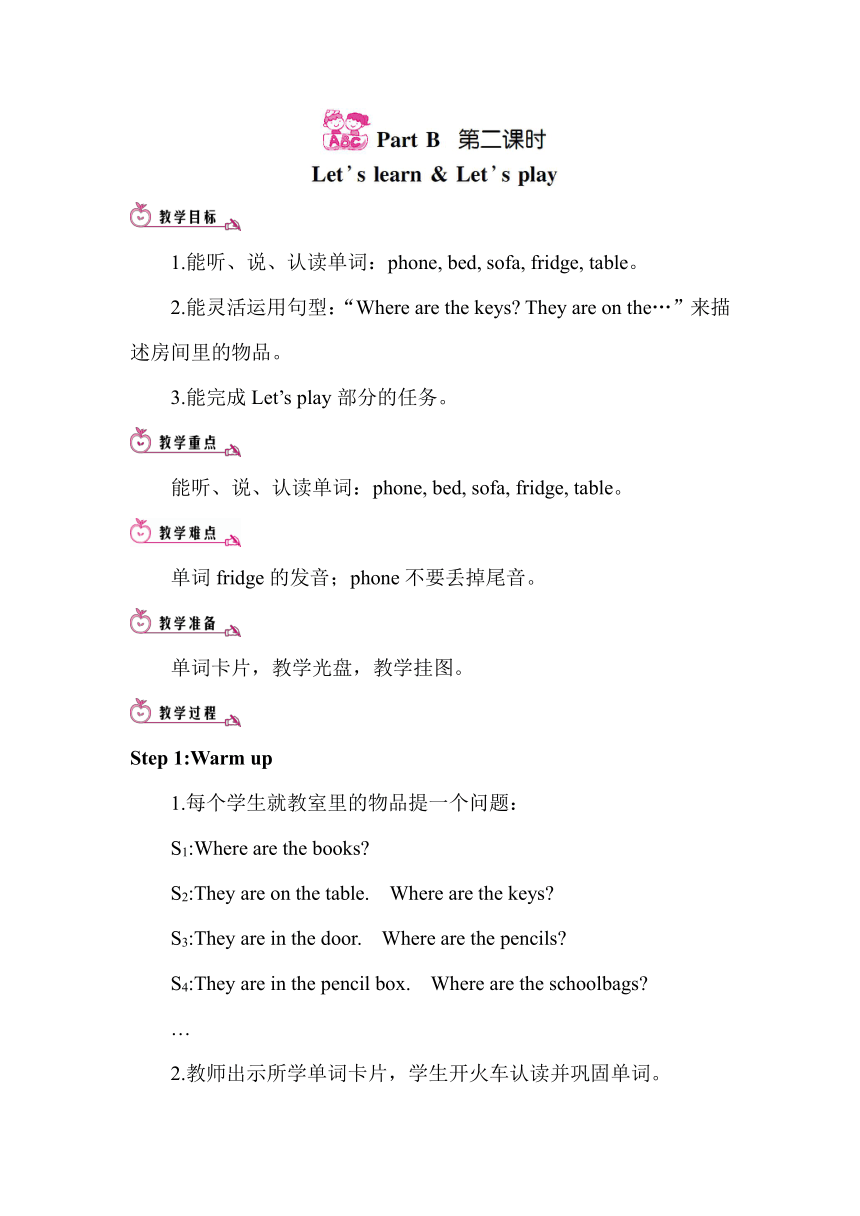Unit 4 My home Part B Let's learn教案(含反思)
文档属性
| 名称 | Unit 4 My home Part B Let's learn教案(含反思) |  | |
| 格式 | doc | ||
| 文件大小 | 216.5KB | ||
| 资源类型 | 教案 | ||
| 版本资源 | 人教版(PEP) | ||
| 科目 | 英语 | ||
| 更新时间 | 2020-07-23 14:24:46 | ||
图片预览

文档简介
1.能听、说、认读单词:phone, bed, sofa, fridge, table。
2.能灵活运用句型:“Where are the keys? They are on the…”来描述房间里的物品。
3.能完成Let’s play部分的任务。
能听、说、认读单词:phone, bed, sofa, fridge, table。
单词fridge的发音;phone不要丢掉尾音。
单词卡片,教学光盘,教学挂图。
Step 1:Warm up
1.每个学生就教室里的物品提一个问题:
S1:Where are the books?
S2:They are on the table. Where are the keys?
S3:They are in the door. Where are the pencils?
S4:They are in the pencil box. Where are the schoolbags?
…
2.教师出示所学单词卡片,学生开火车认读并巩固单词。
Step 2:Presentation
1.教师利用课件呈现一个空房子,然后让学生布置房子,给房子添砖加瓦。教师出示一个电话的声音,提问:房间里首先需要什么?学生回答:电话。引出phone,板书并教读。提醒学生注意phone的发音。
2.教师展示bedroom的图片,并问:卧室里必须要有的是什么?学生回答:bed。教师教读并板书单词。
3.利用课件展示客厅、沙发的图片,并说It’s a sofa.板书并教读单词sofa。
4.教师展示kitchen的图片,并问厨房里需要什么家具,学生回答:冰箱。教师引出fridge,教读并板书,提醒学生注意观察教师的发音。
5.教师指着书桌,T:What’s this? SS: It’s a desk. T:desk是书桌,那餐桌呢?引出table,板书并教读。
6.教师利用课件将所有的家具都摆放整齐,然后问:Where are the keys?
7.播放Let’s learn部分的光盘,学生边跟读边思考问题,学习正确的语音、语调。
Step 3: Consolidation and extension
1.完成Let’s play部分的任务:句子接龙。教师将全班学生分成三人一组进行句子接龙,模仿例句,描述房间里的物品,如:
S1: Look at that room.
S2: Look at that room. It has a blue bed.
S3: Look at that room. It has a blue bed. The bed is near the window.
2.教师发口令,学生画画,如:
Draw a phone. Colour it red.
Draw a table. Colour it yellow.
Draw a fridge. Colour it blue.
Draw a bed. Colour it pink.
Draw a sofa. Colour it brown.
Step 4:Homework
将Let’s learn部分所学的新单词抄写在四线三格里。
本节课学习房间里的物品,教师通过让学生布置房间的大情景来引出新单词。教师利用声音、图画、简笔画、猜猜看等多种形式引入单词,做好知识的过渡。采用视听法,全身反应法来学习单词,练习指令,使得课堂教学形式多样化。
2.能灵活运用句型:“Where are the keys? They are on the…”来描述房间里的物品。
3.能完成Let’s play部分的任务。
能听、说、认读单词:phone, bed, sofa, fridge, table。
单词fridge的发音;phone不要丢掉尾音。
单词卡片,教学光盘,教学挂图。
Step 1:Warm up
1.每个学生就教室里的物品提一个问题:
S1:Where are the books?
S2:They are on the table. Where are the keys?
S3:They are in the door. Where are the pencils?
S4:They are in the pencil box. Where are the schoolbags?
…
2.教师出示所学单词卡片,学生开火车认读并巩固单词。
Step 2:Presentation
1.教师利用课件呈现一个空房子,然后让学生布置房子,给房子添砖加瓦。教师出示一个电话的声音,提问:房间里首先需要什么?学生回答:电话。引出phone,板书并教读。提醒学生注意phone的发音。
2.教师展示bedroom的图片,并问:卧室里必须要有的是什么?学生回答:bed。教师教读并板书单词。
3.利用课件展示客厅、沙发的图片,并说It’s a sofa.板书并教读单词sofa。
4.教师展示kitchen的图片,并问厨房里需要什么家具,学生回答:冰箱。教师引出fridge,教读并板书,提醒学生注意观察教师的发音。
5.教师指着书桌,T:What’s this? SS: It’s a desk. T:desk是书桌,那餐桌呢?引出table,板书并教读。
6.教师利用课件将所有的家具都摆放整齐,然后问:Where are the keys?
7.播放Let’s learn部分的光盘,学生边跟读边思考问题,学习正确的语音、语调。
Step 3: Consolidation and extension
1.完成Let’s play部分的任务:句子接龙。教师将全班学生分成三人一组进行句子接龙,模仿例句,描述房间里的物品,如:
S1: Look at that room.
S2: Look at that room. It has a blue bed.
S3: Look at that room. It has a blue bed. The bed is near the window.
2.教师发口令,学生画画,如:
Draw a phone. Colour it red.
Draw a table. Colour it yellow.
Draw a fridge. Colour it blue.
Draw a bed. Colour it pink.
Draw a sofa. Colour it brown.
Step 4:Homework
将Let’s learn部分所学的新单词抄写在四线三格里。
本节课学习房间里的物品,教师通过让学生布置房间的大情景来引出新单词。教师利用声音、图画、简笔画、猜猜看等多种形式引入单词,做好知识的过渡。采用视听法,全身反应法来学习单词,练习指令,使得课堂教学形式多样化。
